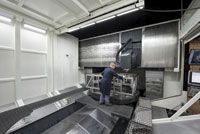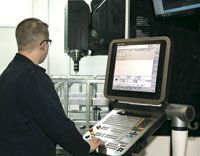Ontario manufacturer continues a legacy of investment in high quality machine tool technology
by Kip Hanson | photos by Ron Ng
Many companies claim to be world class. Weber Manufacturing Technologies Inc. puts its money where its mouth is. So when president Chris Edwards and his team found themselves faced with a continually increasing demand for larger moulds and shorter lead-times, they turned to machine tool builder DMG MORI. Again.
The company’s recently installed DMU 340P five axis machining centre boasts 3,400 mm (134 in.) of X and Y axis travel, a 2,600 mm (102 in.) table, and a whopping 20,000 kg (44,000 lb) capacity. DMG MORI area sales manager Nicholas Piccione says it’s the largest DMU-style machining centre in all of Ontario.
But Weber didn’t stop at just one new machine. The company also purchased a DMC 85 monoBlock machine with three pallets, with another DMC on the way. This makes eight DMG MORI machines, all of which will stand proudly alongside the mouldmaker’s long list of other high quality machine tool brands.
When asked why another DMG MORI, Edwards made no bones about his decision. “They’re still considered the Cadillac of the machining world.”
 Fully integrated
Fully integrated
Vice president of operations Brent Hale explains that Weber Manufacturing is an engineer-to-order tool shop located in Midland. Founded in 1962, the company builds tooling for automotive interiors and exteriors, aerospace structures, and home building products such as sinks and bathtubs. The company currently has 232 employees in its 12,500 sq m (135,000 sq ft) facility.
Aside from its ability to machine very large, very complex moulds and other tooling is the material used to build many of those products: 99.8 per cent pure nickel.
“Our niche is the design and production of nickel tooling using a unique process called NVD (nickel vapor deposition),” he says. “We’re the only manufacturer in the world doing it this way on a large scale commercial basis.”
 Loan me a nickel?
Loan me a nickel?
Nickel is not much fun to machine. Hale says he’ll take Inconel and titanium any day of the week compared to this ultra tough, super strong metal. Nor is it easy to produce, a process that in some cases requires several days of “atom by atom” deposition to generate a shell up to 20 mm thick (0.787 in.), using a vacuum chamber larger than your family sedan.
“Nickel tooling provides significant benefits to our customers,” he says. “The performance is much better than with traditional moulds, offering faster cycle times, greater ability to withstand temperature swings, and a surface that is very smooth. If you were to use a steel or aluminum mould to create an acrylic sink, for instance, the two would bond together. With our tools, the workpiece pops right out.”
NVD is also very good at replicating fine features. Hale notes that if you were to leave a fingerprint on the mandrel used to build the nickel shell, that detail would remain on the finished product. It’s for this reason that NVD is valued by automakers wishing to create leather-grained plastic interiors for their vehicles. Because of this, Weber has produced tooling for the last three generations of Aston Martin vehicles, the Porsche 918, and the instrument panel for the Dodge Challenger.
 Breaking the mould
Breaking the mould
It’s at least partly due to Weber’s success with high performance nickel tooling that management has been pushed to further expand its machining capabilities with the new DMG MORI machines. Yet the tooling manufacturer also machines large quantities of Invar, steel, aluminum, and plastic, and it’s the rigidity needed to remove massive amounts of material together with the tooling’s extreme accuracy requirements that led them to DMG MORI.
“We might hold +/- 0.05 mm (0.002 in.) on a block of metal measuring 1,500 x 2,400 mm (5 x 8 ft.) across, which is awfully tight for a workpiece that large,” Hale explains. “That, together with the need to meet increasingly stringent customer demands, is what led us to this investment in new machine tool technology.”
Weber is no newcomer to five axis machining. Its first such machine, an Ingersoll Master Series M/C C-21212 gantry mill, was purchased in 1997. Each of the 34 machinists at Weber programs their own jobs using hyperMill from CAM provider Open Mind. Each is also cross-trained to operate any machine on the production floor.
“Unlike a lot of shops with a dedicated programming office, all of our machinists have their own programming station at the machine,” he says. “Because we’re doing unique things all the time, you don’t have the luxury of creating the perfect program in an office environment. It just takes too long. We have to get cutting as quickly as possible, and in my point of view, there’s nobody that knows how to do that better than the person on the floor.”
Productive cycles
The recent equipment acquisitions have definitely raised the technology bar at Weber. According to DMG MORI’s Piccione, the machine builder’s integrated “technology cycles” make it possible, for example, to automatically “self-inspect” and tune kinematic accuracy using a simple test routine. In-process tool measurement and breakage monitoring, machine overload protection, and vibration control improve the end result of any machining process while safeguarding valuable assets. Also, the DMU 340P’s HSK 100 spindle is Weber’s first foray into HSK tooling. Based on the results so far, it won’t be their last.
“It’s not uncommon to be stuck with a shopful of CAT 50 holders like we are,” Hale says. “When you have 20 machines and 50 toolholders for each one, changing to a different standard is a tough financial decision to make. But we finally made the leap to HSK and that’s where we’ll stay from here on out. Tool life is better, part accuracy and surface finish are better, everything just runs true.” He laughs. “We told the guys on the 340P that at least they won’t have to worry anymore about the other machinists stealing their toolholders.”
There’s also the palletization to consider. The DMC 85 monoBlock with its three-pallet system has only been on the floor for four months, with the second machine due to arrive this fall. Together the two machines promise to substantially increase throughput.
“Because our cycle times are fairly long, we were already getting 10 to 20 hours of unattended operation weekly per machine, but with the DMC 85s, we can look forward to running around the clock, including weekends,” says Edwards. “Overall, we’re quite pleased with our decision. The folks at DMG MORI have been great to work with, and the 340P especially has allowed us to reduce setup times and further improve part quality. The end result is that we can turn jobs around 30 to 70 per cent faster, freeing the machine for additional work and helping us to grow our business.” SMT
